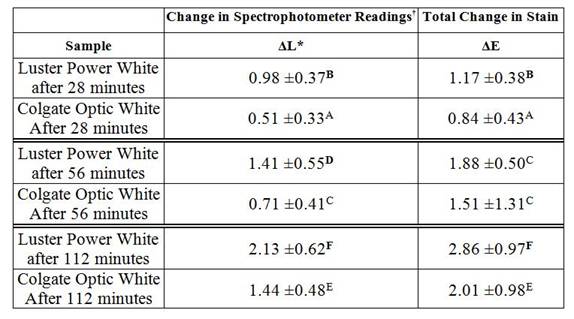Objectives: To evaluate the whitening effect of a two commercially available whitening dentifrices (Luster Power White™ vs. Colgate Optic White®), when applied by manual tooth brushing on intrinsically stained bovine teeth. Methods: Bovine permanent teeth obtained from an abattoir were used to prepare test specimens. In preparation for treatment, tooth specimens were divided into two groups of 12, which had equivalent average baseline intrinsic stain L*a*b* readings. Tests were conducted in an incubator at body temperature (37°C). The dentifrices were applied with a dry, nylon-bristle toothbrush to each tooth specimen, as 2-minute manual brushing treatments. Colorimetric readings were taken at Baseline (to balance the groups), 28, 56 and 112 minutes.
Results:
† Mean ± standard deviation, n = 12. For each variable, group values with a different letter (A,B,C,D,E,F,) were statistically different at p<0.05 using ANOVA.
There was statistically significant change when looking at ΔL* (increase in lightness) at 28, 56, and 112 min (shown above) and at ΔE (overall change in stain) at the 28 and 112 min.
Conclusions: In this In Vitro evaluation, Luster Power White® significantly increased its lightness (ΔL*) compared to Colgate Optic White® after each treatment interval and a ΔE (overall change in stain) at 28 and 112 min.
Keywords: Bleach, Dental materials, Dentifrices, Teeth and Whitening
See more of: Dental Materials 11: Color and Appearance (Esthetics)
![[ Visit AADR's Website ]](images/banner.jpg)
